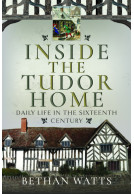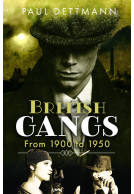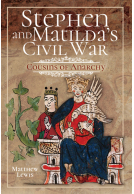The Dark and Dingy Underworld of the Victorian Slums (Hardback)
Imprint: Pen & Sword History
Pages: 232
Illustrations: 30 mono illustrations
ISBN: 9781399036986
Published: 21st January 2025
(click here for international delivery rates)
Order within the next 9 hours, 59 minutes to get your order processed the next working day!
Need a currency converter? Check XE.com for live rates
Dirt. Depravity. Danger. Disease.
From the slurry-filled sewers to the most overcrowded of tenement blocks, Victorian Britain thrummed with the heartbeats of those who had lived there. Infants and children, adults and elders had called these twisting labyrinthian warrens home; here they had laboured, they had loved, they had lost. These people had celebrated progress and had fought for reform; they had raised families, fallen in love, worked laborious jobs, and lamented the deaths of their loved ones.
In her second book, Bethan Catherine Watts explores every crevice of the dark and dingy slums of Victorian Britain and illuminates the lives of those who lived there. From favourite pastimes, recipes and beauty practices to the treatment of children, animals and the dead, The Dark and Dingy Underworld of the Victorian Slums sheds light on those who were born, who had lived, and who had died in nineteenth-century British slums.
Rating: 5 out of 5 stars
NetGalley, Lindsay Speed
As a reader of a lot of historical romance and historical fiction, I love getting the details and background of the time in which the stories are written.
Victorian London in particular has a seedy and dark history that The Dark and Dingy Underworld of the Victorian Slums dives right into headfirst!
This is a perfect resource for anyone who wants to just get a feeling for the timeframe or someone looking for research for their own creative endeavour.
This book is full of information, but it’s delivered in a very palatable and interesting way with a great organization of the topics.
Rating: 5 out of 5 stars
NetGalley, Tara Keating
Really interesting and intriguing reading, I loved how engaging this was and how it kept me interested even at the most bleak points. Thoroughly well researched and well written.
"(The) book provides a compelling and realistic context for family historians to discover what life was like for their forebears, as they struggled to survive in the city."
WDYTYA? Magazine - March 2025
Rating: 5 out of 5 stars
NetGalley, Jayce Torben
Many things impressed me in this book, particularly the compassionate view of the people living in poverty. The details of the economic situation, the impact of the industrial revolution, and the greed of landlords and employers goes a long way toward exploding myths about slum dwellers. Then as now, many people found it useful to blame the poor for their plight.
The organization by broad topics works beautifully, and there's a wealth of primary and secondary sources. Although some details make for sad reading, there are uplifting discussions as well, including more myth-busting in regards to hygiene. I was fascinated to learn that two of Jack the Ripper's victims had small cakes of soap with them.
Personal adornment was creative, and there were entertainments available to everyone. After learning about workhouse and factory horrors, I cheered for social reformers who made an impact on the number of hours worked by children and exposed inhumane living conditions. Over time, determined individuals made a difference in laws affecting these drastically exploited people.
An example of one shocking thing I learned: Children's work hours were initially *reduced* to ten hours per day. Later reforms reduced the hours further and raised the minimum age.Bethan Watts centers her work on London slums and includes other areas as well, such as Edinburgh to add data and further insights into living conditions and demographics.
The references to the workhouse experiences of Charles Dickens deepened my appreciation of his books. I've had a strong interest in Victorian London for many years. It was wonderful to read such a comprehensive and well-researched exploration of the social conditions contributing to the vast, debilitating poverty in this era.
The author's attention to the nitty-gritty details of daily life brought the slums to life in all their squalor and misery--and gave glimpses of the indomitable human spirit that helped people survive and in many cases practice kindness toward each other. An observation by the queen highlighted the spirit she saw in London's poor.
I highly recommend The Dark and Dingy Underworld of Victorian Slums to readers interested in the history and literature of this era, and for general readers as well. The writing style makes the topics accessible--it isn't dry or densely academic. Anyone who is interested in the topic will find this an enlightening reading experience.
I thought this book was going to be just about the Criminal aspect of the Victorian slums, but it was that and so much more. It talks about the fashion, the culture, the hygiene, every aspect of Victorian life was covered. I don't know much about any of the Victorian era, let alone the Victorian slums. If you have an interest in Victorian London, or really any history, you'll love the book.
NetGalley, Mike Jacobs
Rating: 5 out of 5 stars
NetGalley, Mel Smith
I love reading about the Victorian era I find it fascinating to think about how life was then for people compared to how things are now. This was an informative and enjoyable book and kept me engaged. Would definitely recommend if you have an interest in the Victorian Era.
Rating: 5 out of 5 stars
NetGalley, Pippa Elliott
I braced myself for a gritty (nay, depressing) read about the harsh realities of life for those living in the squalor of the Victorian Slums. But I was wrong to do so. The information in book was engrossing and the author has written in a way that brings the time to life in a most engaging way.
Yes, life was hard, for example a contemporary account described London hovels as “lairs into which a starving dog might creep to die, but nothing more.” But its not all doom and gloom. There was the uplifting sense of community in many of the slums, where people who had next-to-nothing understood the importance of sharing what little they had and supported one another. Indeed, Queen Victoria was surprised by this and observed that the lower classes were remarkably jovial.
There were some unexpected champions, such as Charles Booth in 1884, who undertook to survey the slums to find out exactly who and how many people resided there. And tales of the early feminist, Louisa Twining (of Twining’s tea fame) who campaigned for better working conditions for women.
I especially enjoyed the chapter about how slum-dwellers had the same human desire to keep clean and healthy, and how they went about doing this. Down this rabbit hole lay some interesting facts about soap, the types available, and how highly it was prized (For example, did you know that one of Jack the Ripper’s victims had some soap in her pocket – a prized possession that she kept on her at all times).
Victorian Slums embraces not just the slums, but all aspects of life for the lower classes during the 19th century. I thoroughly enjoyed the read and can see myself re-reading it in the near future.
A fantastic overview of life in the slums of Victorian London, covering not just the living conditions but things like fashion, cosmetics, hygiene, work and leisure, and also how they died and how their bodies ere cared for after. And so much more! A really great resource.
NetGalley, Meredith Katz
Rating: 5 out of 5 stars
NetGalley, Elena Hodgson
This is a fascinating, well written book that clears up some misconceptions about Victorian life. There were two extremes of life in this time period, the haves and the have nots. The romance novels set in this time period tend to focus on the more well to do. I thought I knew how tough life could be for those unfortunate enough to live in the slums but turns out I didn't really know. I had never heard of the "Great Stink" of 1858 when the Thames was so foul smelling that lime, chalk, and carbolic acid were poured into the river. The things some people scavenged for are appalling. I am not a scholar of this time period and I didn't fact check things. I did however get sidetracked with some of the works cited and search the internet for more information. I will definitely be recommending this book for purchase.
I only started reading this book yesterday and I absolutely ate it up I couldn't put it down. I have always been fascinated by the Victorian era in all its filth and depravity, so I found this super interesting. It was so readable and had obviously been very well researched without coming across as stuffy and boring.
NetGalley, Kirsty Montgomery
I really enjoyed it.
Rating: 5 out of 5 stars
NetGalley, Shannan Lee
Bethan Watts gives you an inside look at life in the slums in Victorian London. It was evident she researched by scouring through both primary and secondary sources. Her writing is easily understandable to a nonacademic audience. This brings the history of the poor of London to the general public. This book reads like a novel without being overly pretentious. Some of the topics she touched on were their destitute housing situations, healthcare, food, funeral practices, and beauty regimes. I have read many books on Victorian London, but this is one of my favorites. It will make an excellent edition for Victorian historians or fans.
Fascinating, informative, eye opening and very entertaining, this was a very enjoyable read. The Victorian times are much documented and as such I have read quite extensively on the subject but this is definitely one of the more rounded and extensive accounts I have enjoyed. The times are of particular interest to me because of the dramatic progress and technological advance which seemingly happened so quickly that you get drawn along by the exciting new times and the fever pitch of innovation and economy. Of course the dramatic progress also had a flip side with the vast numbers of people living in abject poverty, worsened by the lack of sanitation, birth control and government assistance. The gap between the haves and have nots was vast and poignant and the conditions endured by the poor was shocking and sympathetically portrayed and examined by this text.
NetGalley, Helen Frost
The way each area was addressed was refreshing and new and myths tackled head on which gave me confidence in the validity of what I was reading and a wealth of new information on a time I thought I already knew fairly well. Definitely recommend.
Rating: 5 out of 5 stars
NetGalley, Brenda Carleton
The Dark and Dingy Underworld of the Victorian Slums by Bethan Watts highlights the deep chasm between the impoverished, middle class and the wealthy. Charles Dickens wrote with first-hand experience and helped create awareness in the tumultuous time when starvation, cramped quarters, vermin in every corner, dreadful smells, decreased mortality, disease, wading through raw sewer and landlord swindlers were unfortunately daily life for many in London. The Industrial Revolution changed the class structure, population exploded and the poor became poorer. Housing and food became scarce and furniture was rare indeed. People slept in straw on floors and sometimes had no clothing at all. Workhouses forced children as young as six to work long hours for a pittance. Dangerous jobs such as chimney sweeps and cotton mills were common as children were small and more expendable. Drugs such as opium were rife. Even the poorest washed their hair weekly and had access to very cheap soap. The most precious commodities were teaspoons and butter knives.
A few excellent reformers implemented Poor Laws and improved working conditions for children. Eventually, there were actually mealtimes for the poor rather than eating scraps when they could. They earned a bit of leisure time, too. Advancements in germ theory and infectious diseases made strides. Interestingly, though crime was common, the poorest took care of each other and had each other's backs which meant the world to them. Other topics discussed include pregnancy, food storage, death, board games and ragged schools.
I have read umpteen books on the topic and am always saddened to learn more about what so many suffered through, when every minute was about survival. It wasn't life but bare existence. The author captured the range of emotions, practicalities and hopelessness very well. The middle and upper classes were in a completely different world. Thankfully, some used their passion, skills and money to help the poor. But help came far too late for too many.
My sincere thank you to Pen & Sword and NetGalley for providing me with a digital copy of this enthralling book. The photographs are heartbreaking but important.
Rating: 5 out of 5 stars
NetGalley, Anita Wallas
Oh my goodness; there are times in this book when a strong stomach is required and moments of utter heartbreak. Such is the strength of Bethan Watts writing; she brings the bleak and squalid world of Victorian England so vividly to life. I’ve encountered slum living in the 20th century and in many cities, the remains of tenement and court living was still prevalent until slum clearances in the 1960s. But that was luxury compared to the total squalor of Victorian slums. Many thousands were forced to endure a daily grind of unremitting poverty; no food, possessions, work and sewage and vermin running over and through everything. It’s almost beyond imagination and yet people survived and the human spirit, battered and worn but ultimatey indomitable, won through.
Whilst the middle and particularly upper classes thrived on the spoils of the Industrial Revolution, the poor, disenfranchised and powerless, were exploited in every way. Reform was slow, but a handful of individuals worked tirelessly to highlight the disparity and the plight of a large section of the population. This is, without doubt, the best book I’ve read about the social divisions in Victorian England. Well written stark, vivid and memorable, Bethan Watts has researched meticulously and presented a memorable account.
Bethan Watts does a fantastic job in bringing the slums of Britain element and gave a peek into the lifestyle of the time. I thought this was really well written
NetGalley, Kathryn McLeer
It was really dark but really intriguing as I haven't heard of anything like this before.
NetGalley, Rachel Phillips
Rating: 5 out of 5 stars
NetGalley, Karen Bull
Great book, hard think how life would been like for possibly my ancestors.
Well written, worth reading.
About Bethan Watts
Bethan Catherine Watts is a social historian of medieval and early modern history, and specialises in the everyday lives of ordinary people. She is most interested in the lives of children and youths in history, as well as the health, hygiene, and households of past peoples.Bethan holds both a Bachelor’s and a Master’s degree in Medieval History.
















